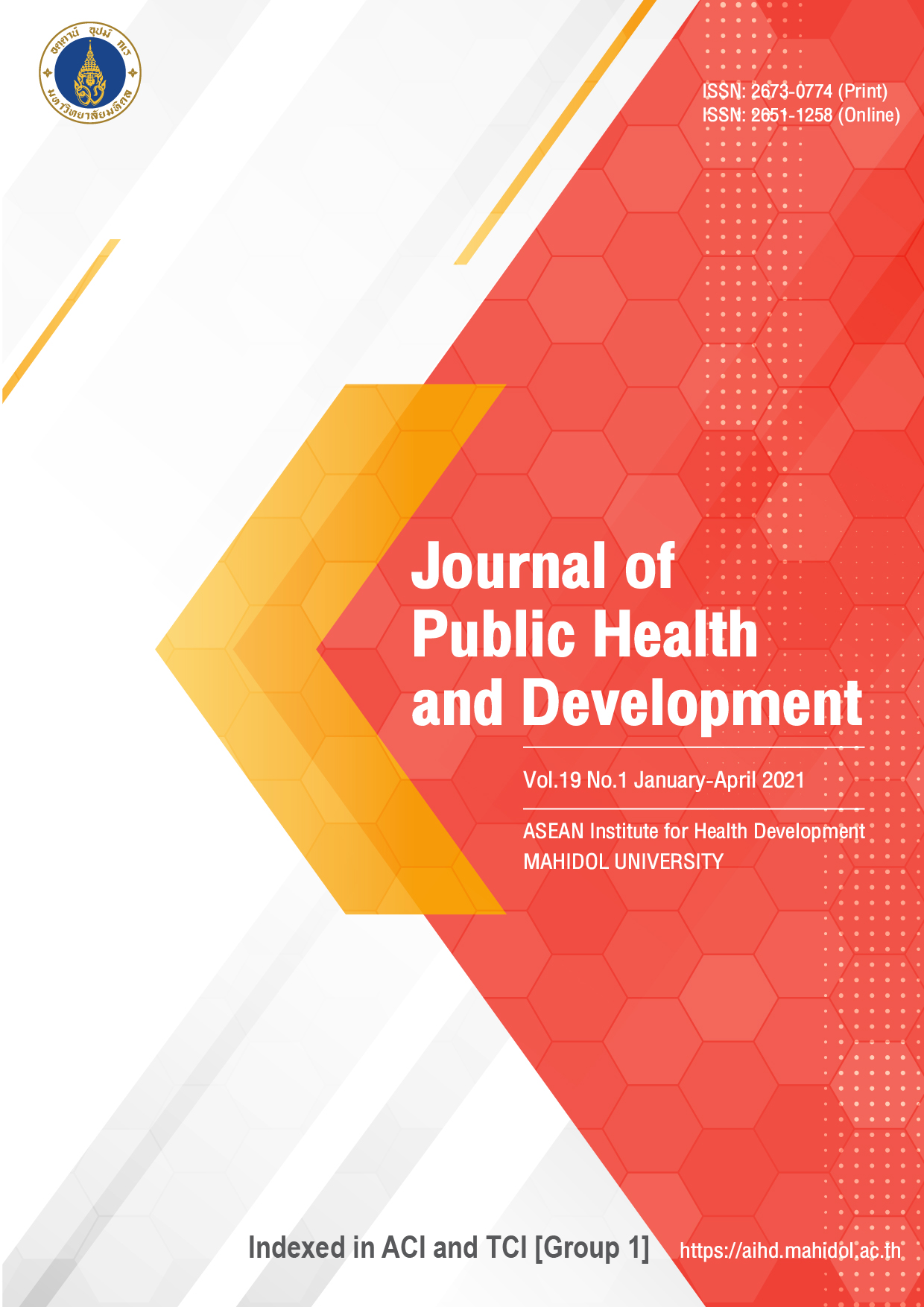Improved immunization access through health systems strengthening project for townships in Myanmar: a mixed method study
Main Article Content
Abstract
Many areas of Myanmar have limited access to immunization due to a range of management, logistics and security barriers. The objectives of this study were to describe the situation of immunization services and the health systems strengthening (HSS) project, and to analyze the effect of the health systems strengthening project on access to immunization services. Mixed-method study design was used. Secondary data for all health systems strengthening and immunization services from 2011 to 2015 were collected. The qualitative data were collected by key informant interviews with 28 key stakeholders from the HSS project and the expanded program on immunization (EPI) project, and six study townships and twelve Rural Health Centers, along with twelve focus group discussions with 121 mothers of children under two years of age. The results showed that DPT3/Pentavalent 3 immunization coverage increased from 79.4 in 2011 to 87.8 in 2015. The integrated service packages were conducted in remote areas. The appointed midwife to PHS 2 ratio went from 6.57 in 2011 to 2.06 in 2015. The government budget mainly supported salaries, and the HSS project supported integrated immunization service packages and supervision. In addition, the basic health staff (BHS) received leadership and management training. In conclusion, the findings of this study provided substantial insight into health systems strengthening factors such as service delivery, healthcare workforce, information, medical products and technology, financing and leadership, improving access to immunization services which have an effect on the national intervention programs and policies, and implementation of interventions.
Article Details
References
Machingaidze S, Wiysonge CS, Hussey GD. (2013) Strengthening the expanded programme on immunization in Africa: looking beyond 2015. PLoS Med;10(3): e1001405. doi: 10.1371/journal.pmed. 1001405
Kawakatsu Y, Honda S. Individual-, family- and community-level deter-minants of full vaccination coverage among children aged 12–23 months in western Kenya. Vaccine. 2012; 30(52): 7588-93. doi: 10.1016/ j.vaccine.2012. 10.037
Etana B, Deressa W. Factors associated with complete immunization coverage in children aged 12–23 months in Ambo Woreda, Central Ethiopia. BMC Public Health. 2012; 12: 566. doi:10.1186/ 1471-2458-12-566
Hemat S, Takano T, Kizuki M, Mashal T. Health-care provision factors associated with child immunization coverage in a city centre and a rural area in Kabul, Afghanistan. Vaccine. 2009; 27(21): 2823-9. doi: 10.1016/j.vaccine. 2009.02.097
Jacobs B, Lindelow M, Xayyavong P, Sackett P. Building on community outreach for childhood vaccination to deliver maternal and child health services in Laos: a feasibility assessment. Reproductive Health Matters. 2012; 20(40): 112-21. doi: 10.1016/S0968-8080(12)40649-8.
Kawakatsu Y, Tanaka J, Ogawa K, Ogendo K, Honda S. Effects of three interventions and determinants of full vaccination among children aged 12–59 months in Nyanza province, Kenya. Public Health. 2015; 129(11): 1530-8. doi: 10.1016/j.puhe.2015.07.008.
Legesse E, Dechasa W. An assessment of child immunization coverage and its determinants in Sinana District, Southeast Ethiopia. BMC pediatrics. 2015; 15: 31. doi: 10.1186/s12887-015-0345-4.
Odusanya OO, Alufohai EF, Meurice FP, Ahonkhai VI. Determinants of vaccination coverage in rural Nigeria. BMC Public Health. 2008; 8:381. doi:10.1186/1471-2458-8-381
Osetinsky B, Gaydos LM, Leon JS. Predictors of completed childhood vaccination in Bolivia. International journal of child and adolescent health. 2015; 8(4): 413-23. Available at: https://www.ncbi.nlm.nih.gov/pmc/articles/PMC4655880/
WHO. Immunization coverage 2016 [cited 2016]. Available from: http:// www.who.int/mediacentre/factsheets/fs378/en/.
Rammohan A, Awofeso N. District-level variations in childhood immunizations in India: The role of socio-economic factors and health infrastructure. Social Science & Medicine. 2015; 145:163-72. doi: 10.1016/j.socscimed.2015.05.004
MOH Myanmar WHO GAVI. Guidelines for Township Health System Assessment 2011. Available at: https://www.burmalibrary.org/docs21/HSS_Assessment_Guidelines_June_13.pdf; 2009.
MOH Myanmar. Coordinated Township Health Planning Guidelines 2009. Available at: http://ihppthaigov. net/DB/publication/attachbook/162/chapter1.pdf
MOH Myanmar. Health in Myanmar (2014), Ministry of Health, Myanmar 2014. Available at: https://mohs.gov. mm/content/publication2014
MOH Myanmar. National Health Plan (2011-2016). Ministry of Health, Myanmar 2013. Available at: https:// mohs.gov.mm/cat/NHP(2011-2016)
MOH Myanmar Expanded Program of Immunization, Health in Myanmar, 2012. pp. 106-11. Available at: https://mohs.gov.mm/content/publication2012
MOH Myanmar Health Systems Strengthening, Health in Myanmar 2012. pp. 45-6. Available at: https://mohs.gov.mm/content/publication2012
WHO. Facilitating Modules 4: Data Analysis and Presentation. Available at: https://158.232.12.119/tdr/publications/year/2014/Facilitators-guide-4_010514.pdf2014.
WHO. Module 4: Data Analysis and Presentation. Available at: https://www.who.int/tdr/publications/year/2014/participant-workbook4_030414.pdf2014.
WHO. Implementation Research Toolkit Workbook. Available at: https://www.who.int/tdr/publications/year/2014/9789241506960_workbook_eng.pdf2014.
WHO. Implementation Research Toolkits Facilitator Guide. Available at: https://apps.who.int/iris/bitstream/ handle/10665/110523/9789241506960_Facilitator_guide_eng.pdf?sequence=2.
WHO. Focus Group Discussions Moderator Guide. Available at: https:// www.who.int/responsiveness/surveys/Focus-Group-Mod-Guide-final.pdf?ua=1; 2001.
WHO. Module 4b: Qualitative Data Collection and Presentation. Available at: https://www.who.int/tdr/ publications/ir-toolkit/Module4b_ Slide_Final.pdf? ua=1.
SAS Support. Generalized Estimating Equations. Available at: https:// supportsascom/rnd/app/stat/topics/gee/geepdf. 2015.
Önder H, Bek Y. 2008. Use of Generalized Estimating Equations in Biological Experiments. Available at: Users/RS5/Downloads/UseofGeneralizedEstimatingEquationsinBiologicalExperimentssadecemakale%20(1).pdf
Owais A, Khowaja AR, Ali SA, Zaidi AKM. Pakistan's expanded programme on immunization: An overview in the context of polio eradication and strategies for improving coverage. Vaccine. 2013; 31(33): 3313-9. doi: 10.1016/j.vaccine.2013.05.015.
WHO. Global Vaccine Action Plan, Secretariat Annual Report 2016. Available at: https://www.who.int/ immunization/global_vaccine_action_plan/gvap_secretariat_report_2016.pdf?ua=12016.
MOH Myanmar. WHO. IHPP Thailand. Performance Assessment of GAVI-HSS Interventions in 20 Townships 2014. Available at: https:// apps.who.int/iris/bitstream/handle/10665/277119/performanceassessmentreport.pdf
Ryman TK, Wallace A, Mihigo R, Richards P, Schlanger K, Cappelier K, et al. Community and health worker perceptions and preferences regarding integration of other health services with routine vaccinations: four case studies. Journal of Infectious Diseases. 2012; 205(suppl 1): S49-S55. doi: 10.1093/infdis/jir796
World Health Organization. The Republic of the Union of Myanmar, Health System Review 2014. Available at: https://iris.wpro.who.int/handle/ 10665.1/11354
MOH Myanmar. Health in Myanmar (2013), Ministry of Health, Myanmar 2013. Available at: https://www.mohs. gov.mm/Main/content/publication/health-in-myanmar-2013
MOH. Myanmar, WHO, UNICEF. Expanded Program on Immunization Multi Year Plan 2012- 2016. Available at: https://origin.searo.who.int/ myanmar/documents/EPImultiyear
MOH Myanmar. WHO. Co-ordinated Township Health Planning Guidelines 2011. Available at: http://ihppthaigov. net/DB/publication/attachbook/162/chapter1.pdf
MOH Myanmar. WHO and HITAP. Mid-term review of Maternal and Child Health Voucher Scheme, Yedarshey Township, Republic of Union of Myanmar 2014. Available at: https://hitap.net/en/document/246752014
35. GAVI. GAVI Alliance Health System Strengthening (HSS) Appli-cations2008. Available at: https:// www.gavi.org/sites/default/files/document/proposal-for-hss-support--myanmarpdf.pdf2008
36. MOH Myanmar. GAVI Alliance. WHO. Health Workforce Strategic Plan 2012-2017. Available at: https:// origin.searo.who.int/myanmar/documents/en/.


